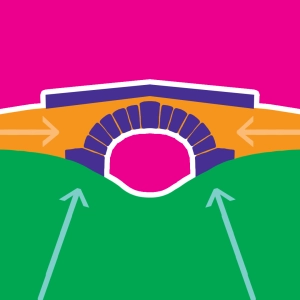 Bridges (Forces)
Bridges (Forces)
Learning objectives
- To distinguish between diffrent types of bridges.
- To view the forces acting on the bridge deck and the distribution of the forces to the banks.
- To identify the parts of the bridge undergoing tensile forces and compressive forces.
The first bridges were the work of the Chinese and Romans. They were wooden and, for greater strength, stone. The largest of these old bridges still in use today take the form of an arch. Such a structure allows the transfer of the load from the center of the bridge to the shore, where the abutments are located.
This force distribution is common to all types of bridges. Forces are distributed and transferred from the deck to the piers and / or abutments on the shores, without interfering with the navigation below the bridge. The materials used are chosen for their resistance to tension and compression.
Each construction project is a unique bridge. There are numerous criteria involved in the choice of the structure: topography of the site, soil geology, environmental climate, costs.

Discover EduMedia for free
The interactive encyclopedia that brings science and math to life in the classroom.
Over 1,000 resources
